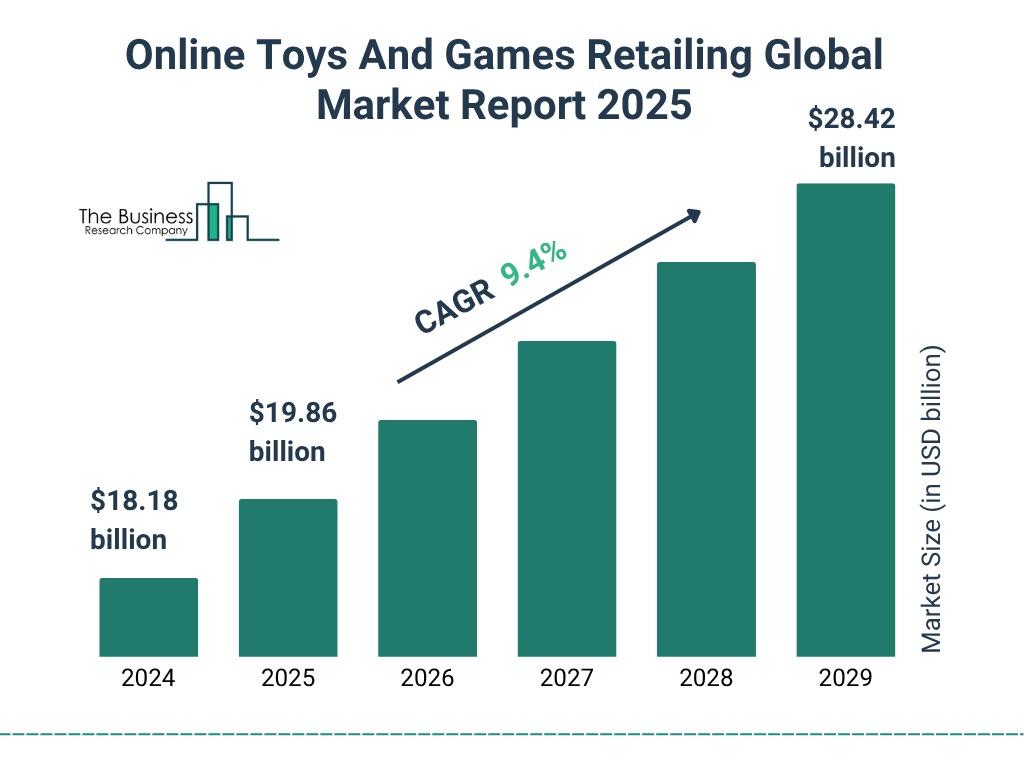Global Online Toys And Games Retailing Market Projected to Strengthen in Value and Scale by 2029
Grab 20% Off With
Code ONLINE20 On Global market Reports – Evaluate Global Trends, Market
Risks, and Competitive Intelligence
What Is the Estimated Market Size and CAGR of the Online Toys And Games
Retailing Market for the Period 2025–2029?
The online toys and games retailing market size has grown strongly in
recent years. It will grow from $18.18 billion in 2024 to $19.86 billion in
2025 at a compound annual growth rate (CAGR) of 9.2%. The growth in the
historic period can be attributed to a growing middle-class population
worldwide, increasing children's TV and internet viewership, a growing trend
towards online shopping, a shift towards e-commerce platforms, and surging
demand for multipurpose playthings.
The online toys and games retailing market size is expected to see strong
growth in the next few years. It will grow to $28.42 billion in 2029 at a
compound annual growth rate (CAGR) of 9.4%. The growth in the forecast period
can be attributed to increasing demand for electronic games, rising
popularity of video games, growing demand for interactive and educational
toys, increasing use of social media for toy and game promotions, and growing
popularity of online gaming and esports. Major trends in the forecast period
include product innovation, the development of learning and educational toys,
artificial intelligence companions and voice recognition in smart toys, and
the adoption of augmented reality (AR) and virtual reality (VR)
technologies.
Get your free report sample today:
https://www.thebusinessresearchcompany.com/sample.aspx?id=18691&type=smp (
https://www.thebusinessresearchcompany.com/sample.aspx?id=18691&type=smp)
What Are the Major Drivers Propelling the Growth of the Online Toys And
Games Retailing Market?
The increasing consumer preference for online shopping and e-commerce is
expected to propel the growth of the online toy and game retail market going
forward. Consumer preference for online shopping and e-commerce is increasing
due to the convenience of home shopping, wider product selection, and the
ability to easily compare prices across multiple platforms. Online shopping
and e-commerce are useful for online toy and game retail by providing a
convenient shopping experience, offering a vast selection of products,
enabling easy price comparisons, and allowing retailers to reach a global
audience. For instance, in May 2024, according to the United States Census
Bureau, a US-based government agency, the first quarter of 2024 total
e-commerce sales in the US rose by 8.6 percent (±1.1%) compared to the first
quarter of 2023. Therefore, the rapid expansion of e-commerce is driving the
growth of the cushion packaging market.
Which Segments Are Likely to Shape the Future Outlook of the Online Toys
And Games Retailing Market?
The online toys and games retailingmarket covered in this report is
segmented –
1) By Type: Plush Toys, Infant Or Pre-School Toys, Activity And Ride-On
Toys, Dolls, Games And Puzzles, Outdoor Seasonal Toys, Other Types
2) By Distribution Channel: E-Commerce Websites, Brand Stores,
Marketplaces
3) By Application: School Age Children, Teens, Infants, Toddlers
Subsegments:
1) By Plush Toys: Stuffed Animals, Character-Themed Plush Toys, Sensory
Plush Toys, Infant or Pre-School Toys
2) By Educational Toys: Musical Toys, Interactive Baby Toys, Activity and
Ride-On Toys, Tricycles and Scooters
3) By Activity Sets: Building and Construction Toys, Dolls, Fashion Dolls,
Baby Dolls, Collectible Dolls
4) By Games and Puzzles: Board Games, Card Games, Jigsaw Puzzles
5) By Outdoor Seasonal Toys: Water Toys, Sports Equipment, Playground Toys
6) By Other Types: Electronic Toys, STEM Toys, Action Figures
Which Major Trends Are Expected to Define the Online Toys And Games
Retailing Market Through 2029?
Major companies operating in the online toy and game retail market are
focusing on prioritizing the expansion of digital platforms, such as online
e-commerce marketplaces, to enhance the customer experience, increase sales,
and expand their market reach. An online e-commerce marketplace refers to a
digital platform where multiple sellers can list and sell their products or services,
and consumers can browse, compare, and purchase from a wide range of
offerings in one place. For instance, in June 2024, Tesco PLC, a UK-based
retail company, launched a new online marketplace, allowing customers to shop
thousands of third-party products alongside Tesco's grocery offerings on
Tesco.com (
http://Tesco.com) and the Tesco app. The initial launch features around 9,000
products across categories such as DIY, garden, homeware, toys, and games.
These third-party products are sold and fulfilled directly by Tesco's trusted
partners, while Tesco's grocery orders continue to be fulfilled from local
stores or fulfillment centers. Tesco is ensuring these sellers meet robust
requirements and standards for delivery speed, returns, and customer
satisfaction and will monitor their performance on an ongoing basis.
Who Are the Principal Market Leaders in the Online Toys And Games Retailing
Market?
Major companies operating in the online toys and games retailing market are
Kohl's Corporation, LEGO System A/S, Nordstrom Inc., Mattel Inc., GameStop
Corporation, Hasbro Inc., Barnes & Noble Inc., TOMY Company Ltd.,
Ravensburger AG, BFL Group, Oompa Toys, Simba Dickie Group GmbH,
UncommonGoods LLC, Hamleys of London Ltd, Tru Kids Inc., Le Toy Van Limited,
Babesta LLC, Kidding Around Toys, Mary Arnold Toys, Tin Toy Arcade LLC,
Toycra, ToysPlanet LLC
Get the detailed online toys and games retailing market report today
https://www.thebusinessresearchcompany.com/report/online-toys-and-games-retailing-global-market-report (
https://www.thebusinessresearchcompany.com/report/online-toys-and-games-retailing-global-market-report)
Which Regions Are Expected to Record the Strongest CAGR in the Online Toys
And Games Retailing Market?
Asia-Pacific was the largest region in the online toys and games retailing
market in 2024. The regions covered in the online toys and games retailing
market report are Asia-Pacific, Western Europe, Eastern Europe, North
America, South America, Middle East, Africa.
#Contact Us:#
The Business Research Company
Market Research Reports (
https://thebusinessresearchcompany.com/)
Americas +1 310-496-7795
Asia +44 7882 955267 & +91 8897263534
Europe +44 7882 955267
Email: info@tbrc.info (mailto:info@tbrc.info)
#Follow Us On:#
LinkedIn:
The Business Research Company | LinkedIn (
https://in.linkedin.com/company/the-business-research-company)
Global Online Toys And Games Retailing Market Projected to Strengthen in Value and Scale by 2029
Grab 20% Off With
Code ONLINE20 On Global market Reports – Evaluate Global Trends, Market
Risks, and Competitive Intelligence
What Is the Estimated Market Size and CAGR of the Online Toys And Games
Retailing Market for the Period 2025–2029?
The online toys and games retailing market size has grown strongly in
recent years. It will grow from $18.18 billion in 2024 to $19.86 billion in
2025 at a compound annual growth rate (CAGR) of 9.2%. The growth in the
historic period can be attributed to a growing middle-class population
worldwide, increasing children's TV and internet viewership, a growing trend
towards online shopping, a shift towards e-commerce platforms, and surging
demand for multipurpose playthings.
The online toys and games retailing market size is expected to see strong
growth in the next few years. It will grow to $28.42 billion in 2029 at a
compound annual growth rate (CAGR) of 9.4%. The growth in the forecast period
can be attributed to increasing demand for electronic games, rising
popularity of video games, growing demand for interactive and educational
toys, increasing use of social media for toy and game promotions, and growing
popularity of online gaming and esports. Major trends in the forecast period
include product innovation, the development of learning and educational toys,
artificial intelligence companions and voice recognition in smart toys, and
the adoption of augmented reality (AR) and virtual reality (VR)
technologies.
Get your free report sample today:
https://www.thebusinessresearchcompany.com/sample.aspx?id=18691&type=smp (https://www.thebusinessresearchcompany.com/sample.aspx?id=18691&type=smp)
What Are the Major Drivers Propelling the Growth of the Online Toys And
Games Retailing Market?
The increasing consumer preference for online shopping and e-commerce is
expected to propel the growth of the online toy and game retail market going
forward. Consumer preference for online shopping and e-commerce is increasing
due to the convenience of home shopping, wider product selection, and the
ability to easily compare prices across multiple platforms. Online shopping
and e-commerce are useful for online toy and game retail by providing a
convenient shopping experience, offering a vast selection of products,
enabling easy price comparisons, and allowing retailers to reach a global
audience. For instance, in May 2024, according to the United States Census
Bureau, a US-based government agency, the first quarter of 2024 total
e-commerce sales in the US rose by 8.6 percent (±1.1%) compared to the first
quarter of 2023. Therefore, the rapid expansion of e-commerce is driving the
growth of the cushion packaging market.
Which Segments Are Likely to Shape the Future Outlook of the Online Toys
And Games Retailing Market?
The online toys and games retailingmarket covered in this report is
segmented –
1) By Type: Plush Toys, Infant Or Pre-School Toys, Activity And Ride-On
Toys, Dolls, Games And Puzzles, Outdoor Seasonal Toys, Other Types
2) By Distribution Channel: E-Commerce Websites, Brand Stores,
Marketplaces
3) By Application: School Age Children, Teens, Infants, Toddlers
Subsegments:
1) By Plush Toys: Stuffed Animals, Character-Themed Plush Toys, Sensory
Plush Toys, Infant or Pre-School Toys
2) By Educational Toys: Musical Toys, Interactive Baby Toys, Activity and
Ride-On Toys, Tricycles and Scooters
3) By Activity Sets: Building and Construction Toys, Dolls, Fashion Dolls,
Baby Dolls, Collectible Dolls
4) By Games and Puzzles: Board Games, Card Games, Jigsaw Puzzles
5) By Outdoor Seasonal Toys: Water Toys, Sports Equipment, Playground Toys
6) By Other Types: Electronic Toys, STEM Toys, Action Figures
Which Major Trends Are Expected to Define the Online Toys And Games
Retailing Market Through 2029?
Major companies operating in the online toy and game retail market are
focusing on prioritizing the expansion of digital platforms, such as online
e-commerce marketplaces, to enhance the customer experience, increase sales,
and expand their market reach. An online e-commerce marketplace refers to a
digital platform where multiple sellers can list and sell their products or services,
and consumers can browse, compare, and purchase from a wide range of
offerings in one place. For instance, in June 2024, Tesco PLC, a UK-based
retail company, launched a new online marketplace, allowing customers to shop
thousands of third-party products alongside Tesco's grocery offerings on
Tesco.com (http://Tesco.com) and the Tesco app. The initial launch features around 9,000
products across categories such as DIY, garden, homeware, toys, and games.
These third-party products are sold and fulfilled directly by Tesco's trusted
partners, while Tesco's grocery orders continue to be fulfilled from local
stores or fulfillment centers. Tesco is ensuring these sellers meet robust
requirements and standards for delivery speed, returns, and customer
satisfaction and will monitor their performance on an ongoing basis.
Who Are the Principal Market Leaders in the Online Toys And Games Retailing
Market?
Major companies operating in the online toys and games retailing market are
Kohl's Corporation, LEGO System A/S, Nordstrom Inc., Mattel Inc., GameStop
Corporation, Hasbro Inc., Barnes & Noble Inc., TOMY Company Ltd.,
Ravensburger AG, BFL Group, Oompa Toys, Simba Dickie Group GmbH,
UncommonGoods LLC, Hamleys of London Ltd, Tru Kids Inc., Le Toy Van Limited,
Babesta LLC, Kidding Around Toys, Mary Arnold Toys, Tin Toy Arcade LLC,
Toycra, ToysPlanet LLC
Get the detailed online toys and games retailing market report today
https://www.thebusinessresearchcompany.com/report/online-toys-and-games-retailing-global-market-report (https://www.thebusinessresearchcompany.com/report/online-toys-and-games-retailing-global-market-report)
Which Regions Are Expected to Record the Strongest CAGR in the Online Toys
And Games Retailing Market?
Asia-Pacific was the largest region in the online toys and games retailing
market in 2024. The regions covered in the online toys and games retailing
market report are Asia-Pacific, Western Europe, Eastern Europe, North
America, South America, Middle East, Africa.
#Contact Us:#
The Business Research Company
Market Research Reports (https://thebusinessresearchcompany.com/)
Americas +1 310-496-7795
Asia +44 7882 955267 & +91 8897263534
Europe +44 7882 955267
Email: info@tbrc.info (mailto:info@tbrc.info)
#Follow Us On:#
LinkedIn:
The Business Research Company | LinkedIn (https://in.linkedin.com/company/the-business-research-company)











